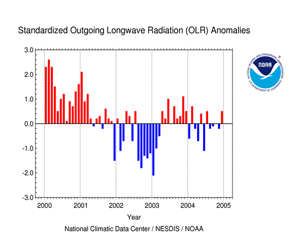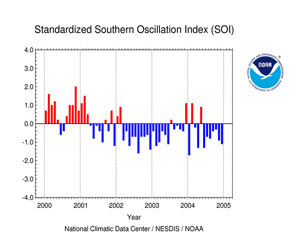OCEANIC CONDITIONS:
The El Niño/Southern Oscillation (ENSO) cycle began the year in a neutral phase, and ended the year in a weak to moderate warm event. This transition was reflected in the surface and subsurface temperature anomalies in the equatorial Pacific Ocean. Above average sea-surface temperature (SST) anomalies have been observed in the western equatorial Pacific Ocean since July 2001, and in the equatorial central Pacific since July 2003. Although at the beginning of 2004, the SST anomalies in both of these regions were above average, they remained below NOAA's official threshold for an El Niño warm event. A slight cooling trend was observed in the equatorial Pacific in early 2004, and by March the temperature anomalies in both the western and central parts of the basin were near-neutral, but still slightly above average.
A gradual warming trend of the equatorial SSTs began in the western Pacific in late-March, which spread eastward into the central Pacific in April. However, it did not spread further east into the eastern Pacific basin or along the South American coast. After a brief period of cooling and decreasing temperature anomalies in June, a more pronounced warming trend was initiated by an oceanic Kelvin wave in late June and early July. The observed warming in July brought the SST anomalies in both the equatorial western and central Pacific basin above the +0.5°C level, where they have remained in both the Niño 3.4 and Niño 4 regions through December.
The SST anomalies in the eastern Pacific began to increase in late August as another oceanic Kelvin wave moved eastward into the region, reinforcing the warm ocean temperature anomalies by depressing the oceanic thermocline and decreasing equatorial upwelling. By mid-October the SST anomalies in the Niño 1+2 region had warmed to above average as well, and warmer than average SSTs were observed across the entire equatorial Pacific basin by the end of the month. The most recent monthly averaged measurements from December continued to reflect the development of weak El Niño conditions, as the SST anomaly in the Niño 3.4 region was +0.81°C (+1.46°F), while the SST anomaly in the Niño 4 region was +0.98°C (+1.76°F). However, the December SST anomalies remained only slightly above average in the eastern Pacific region and along the South American coast, which suggests that the present warm event remains relatively weak and has yet to take hold basin-wide.
ATMOSPHERIC CONDITIONS:
The Southern Oscillation Index (SOI) showed considerable month to month variability during the first half of 2004. The SOI switched signs several times during the January to June period, with no persistent negative or positive trend. A more consistent trend in sea-level pressure developed in June and continued through December, with the SOI has remaining negative for seven consecutive months. The most recent value of the SOI was -1.1 for the December monthly average.
Despite the consistent negative values observed with the SOI over the past seven months, the Outgoing Longwave Radiation (OLR) Index has shown only a very weak sign of a convective response to the warm SSTs in the equatorial Pacific. After switching signs several times from January to August, the OLR Index was slightly negative or zero (i.e. near-neutral) from August through November. In December, the OLR Index switched back to a positive value of 0.5. Therefore, despite the development of an El Niño warm event in the equatorial Pacific Ocean over the past several months, atmospheric convection continued to lag the warm SSTs and oceanic forcing.
GRAPHICS AND INDICES
Sea-Surface Temperatures (SSTs) and Mixed-Layer Conditions:SST anomalies have been above average in the western and central equatorial Pacific throughout 2004. The most significant warming, and the likely period of initiation of the current warm event conditions, occurred during the Boreal summer months (Jun/Jul/Aug).
The most pronounced rise in ocean surface temperatures occurred during July, and the SST anomalies have remained above normal through December across the western and central equatorial Pacific, as reflected in both the Niño 3.4 and Niño 4 indices (map of Niño regions). Including the monthly anomaly from December, there have been six consecutive months with SST anomalies above 0.5°C in the Niño 3.4 index. (NOTE: A running 3-month mean SST anomaly above +0.5°C in the Niño 3.4 region is one indicator that an El Niño is occurring. For the official NOAA classification scheme, please see NOAA's El Niño/La Niña Index Definition as well as the CPC ENSO Diagnostic Discussion for their latest official assessment of ENSO conditions.)
In the western Pacific, the monthly averaged SST anomalies have also warmed since July, with a slight increase in SSTs during December, as reflected in the Niño 4 index value which was +0.98°C (+1.76°F) for the month.
Above average ocean temperatures were also observed in the mixed-layer during 2004, with the largest monthly averaged temperature anomalies reaching 3°C in January, July, November, and December. In addition, the depth of the 20°C isotherm increased during the latter half of 2004.
For the most recent ocean surface temperature conditions, please see the satellite-derived weekly SST anomalies for 2004.
Equatorial Zonal Winds (U-Component Winds) and Sea-Level Topography:
Several distinct periods of below normal easterly trade wind flow were observed across the western and central equatorial Pacific basin during 2004. These periods of anomalously weak trade winds decreased equatorial upwelling in the mixed-layer, which increased the monthly averaged SST anomalies as well as the heat content anomalies in the mixed-layer across the equatorial Pacific region.
Using low-level cloud-tracked winds at 850 hPa (850 mb), zonal wind anomalies were averaged over the equatorial region (between 5°N-5°S). The most pronounced negative zonal wind anomalies were observed during January, March-April, June, August and October, all of which correlates well with periods of Madden-Julian Oscillation (MJO) related activity. Each of these events were characterized by the following conditions: development of westerly winds in the far western Pacific, decreases in the near-equatorial easterly flow in the central Pacific, and the initiation of an oceanic Kelvin wave that propagated eastward across the basin.
Satellite altimetry of ocean surface topography from the NASA/JPL Jason-1 satellite over the Pacific basin and global oceans also reflects the development and propagation of Kelvin waves in the oceanic mixed-layer. Increases in sea-level, shown on these images as positive sea-level anomalies, developed in the western equatorial Pacific and subsequently propagated eastward. The most recent of these Kelvin wave events is shown in the two Jason-1 sea-level anomaly images from December (i.e. 12 December 2004 and 27 December 2004 overpasses).
Outgoing Longwave Radiation (OLR):
No significant large-scale OLR anomalies developed in the equatorial Pacific region in 2004. This is illustrated on the map to the left, which shows the spatial pattern of monthly averaged global OLR (in W m-2) observed by satellite during December. The above average OLR anomalies in the western Pacific west of the dateline reflected areas of enhanced tropical convection, while areas east of the dateline along the equator were near-normal. In general, the majority of the equatorial Pacific region had near-normal OLR and small departures from normal during December. The only exception was an area of negative OLR anomalies in the northwest Pacific associated with tropical cyclone activity. The most recent 3-month averaged OLR anomalies were also near-normal along the equator from the dateline to the South American coast, which reflects the current lack of organized convection in the equatorial Pacific associated with El Niño.
The OLR Index values have shown no consistent trend in 2004, and switched signs several times during the first half of the year. The most recent monthly averaged OLR Index value for December was +0.5 across the region centered over the dateline in the western Pacific between 160° E and 160° W. Therefore, the convective response of the atmosphere to the warm SST anomalies in the western and central equatorial Pacific has been limited, since the OLR Index has remained near-neutral (although slightly negative).
High frequency variability in OLR is typically associated with the Madden-Julian Oscillation (MJO) (MJO related convective activity propagates west to east in the near-equatorial region from the Indian Ocean into the Pacific Ocean approximately every 30-60 days). The latest MJO activity can be seen in CPC's graphs of Daily MJO Indices.
Southern Oscillation Index (SOI):
Similar to the OLR Index, the standardized SOI showed pronounced variability during the first half of 2004, and also switched signs several times between January and June. However, since June the SOI has remained negative, with a December averaged SOI value of -1.1, which is the seventh consecutive month of a negative index. Negative values of the SOI are consistent with ENSO warm event (i.e. El Niño) conditions. Despite this recent trend in the SOI, the index has fluctuated several times between a near-neutral value and a more negative index associated with warm event conditions. This suggests that the atmosphere has failed to respond strongly to the above average SSTs and oceanic forcing in the equatorial Pacific during the Boreal fall and early winter. Therefore, El Niño conditions in the Pacific basin remained weak to moderate at the end of December 2004.
Additional Links
- ENSO Monitoring
- NOAA El Niño / La Niña Index Definition
- NOAA's Pacific Marine Environmental Laboratory (PMEL):
- NOAA's Climate Prediction Center (CPC):
- NOAA's Physical Science Laboratory
- NASA/JPL Ocean Surface Topography from Space
- Australian Bureau of Meteorology (BoM) Climate Driver Update
- IRI - International Research Institute
 NOAA's National Centers for Environmental Information
NOAA's National Centers for Environmental Information
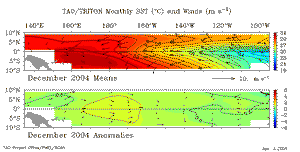
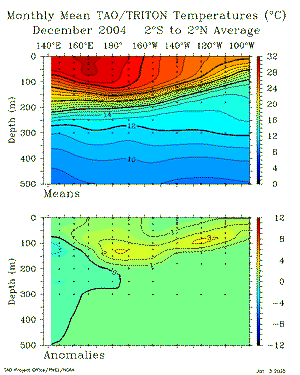
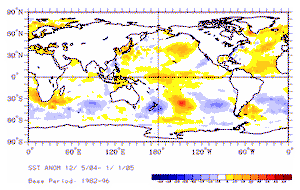
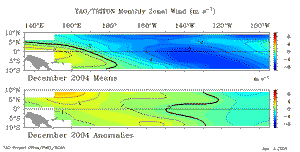
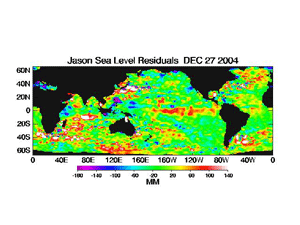
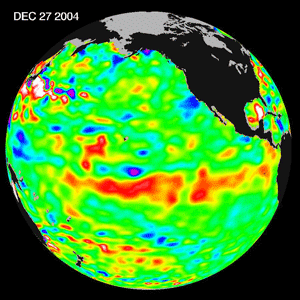
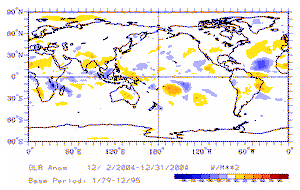
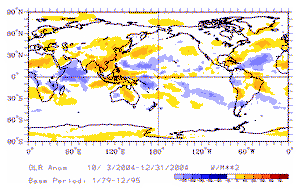 larger image
larger image